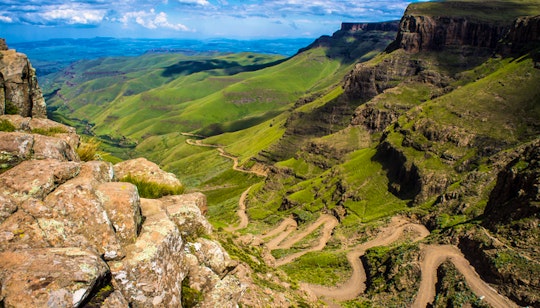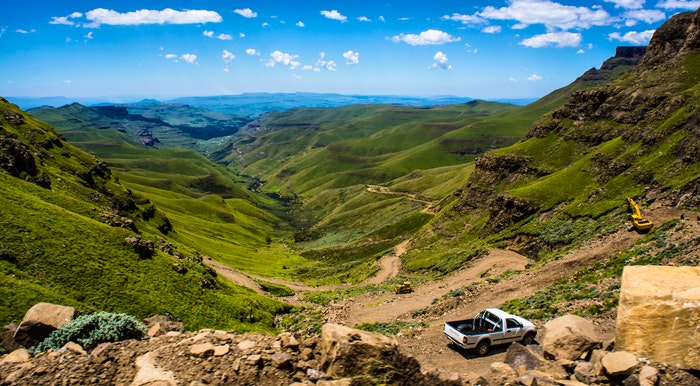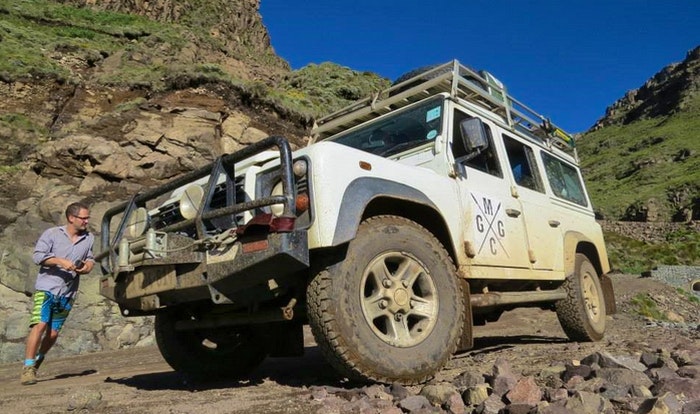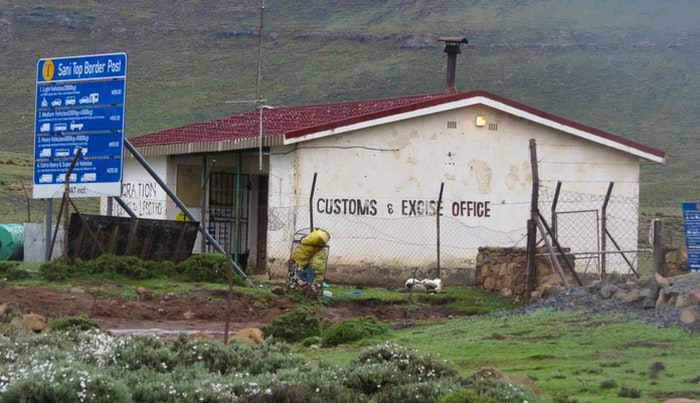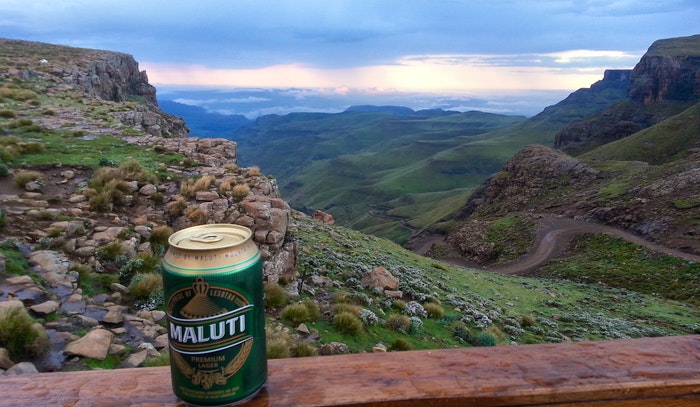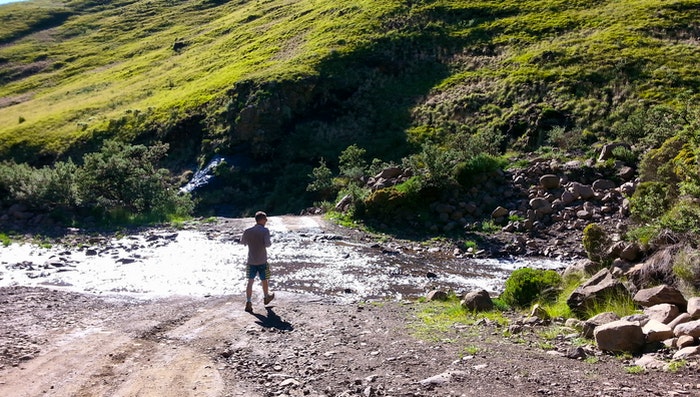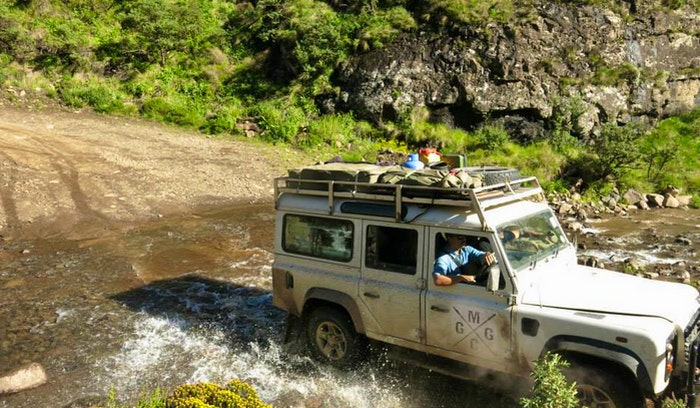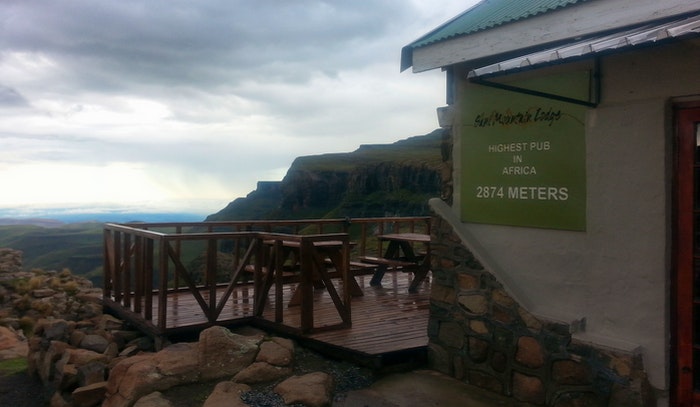The beloved Sani Pass as we know it will soon be a thing of the past. The tarring of this notorious gravel road that links KwaZulu-Natal and the Mountain Kingdom of Lesotho has been approved by Environmental Affairs Minister, Edna Molewa, and will begin in early 2015. This gruelling 4×4 route, 32km North West of Himeville, attracts 4×4 enthusiasts from all over the world. The no man’s land between the South African and Lesotho border posts falls in the Mkhomazi Wilderness Area, which offers beautiful and challenging terrain and unforgettable views over the Mkomazana River. The appeal of the pass has always been its gravel and the sense of adventure the rugged road provides which is why we encourage all 4×4 enthusiasts to drive the pass one more time before the route is tarred.
The Sani Pass was originally developed as a bridle path in 1913 and used as a trade route between South Africa and Mokhotlong (Lesotho). All goods were transported by pack mule. The odd donkey and horse can still be seen plodding up the steep route today.
While the tarred road will certainly sadden 4×4 lovers, it will provide easy access for those with ordinary vehicles and improve trade relations between South Africa and Lesotho. “Seamless and legal movement of people between the two countries will help strengthen our economic ties, grow shared opportunities and ensure sustainable and mutually beneficial development for both countries,” said KwaZulu-Natal transport MEC, Willies Mchunu. The total cost of tarring the 19km route, from the Old Good Hope Trading Post to the summit of the Sani Pass, will be R887 million.
DRIVING THE SANI PASS
The Sani Pass, also known as the Roof of Africa, takes travellers along a spectacular 9km mountain road that snakes its way from Underberg in the Drakensberg in South Africa, into the Mountain Kingdom of Lesotho. The route up the Sani Pass begins at 1,544m and climbs 1,332m vertically to a final height of 2,876m. Allow at least 2 hours to get to the top without rushing and enough time to reach the border post before close.
The route traverses through several shallow water crossings (and waterfalls after the summer rains), hairpin bends, and switchbacks with angles between 130˚ – 180˚. There is only one view site on the pass with enough parking for 6 vehicles. Other stops will have to be risked on hairpin bends. While the route can be hairy, the dramatic mountain scenery, beautiful streams, and fresh mountain air makes it worthwhile.
The route demands 100% concentration. Drivers must remain cautious as the pass has been known to claim the lives of careless drivers. The remains of some of the vehicles that have teetered over the edge can still be seen today; providing a startling reminder of the hazards that can occur. Take a tip from the tortoise: slow and steady wins the race.
Car Talk
- The Sani Pass is both challenging and dangerous and requires use of a 4×4 vehicle (2×4 vehicles have to be pre-approved). While South African immigration at the bottom of the pass stops vehicles not fit for the journey, the Lesotho border agents at the summit usually allows all types of vehicles to descend.
- The average gradients are 1:20, but the final part of the route can be 1:3 with mud, ice and snow possible at almost any time of the year.
- The first stretch is best driven in high range, first and second gears. The final 3km is best driven in low range, second and third gears.
- Ascending cars and pack mules have right of way.
- Allow enough daylight hours to appreciate the view and get some good photos.
Weather
During summer, the area can experience severe electrical storms with heavy rain and winds (important note for motorcyclists). In winter, snow and ice are common, with snow occurring as late as October. Temperatures of -15˚C are common in winter, with the record low being -17.5˚C, but it can get very chilly even in summer. Due to the high altitude, you may experience shortness of breath if you do a fair amount of walking. The pass is frequently closed due to the weather so be sure to phone ahead to see whether it’s open.
Border Posts
Both the South African and Lesotho border posts are fast and efficient, situated less than 8km apart. Passports are required and will be stamped at both border posts. Vehicle documents are recommended but not obligatory. Check the Lesotho passport requirements. There are clean toilet facilities at the South African border post.
- Times: 06:00 – 18:00
- Contact: +27 (0)33 702 1169
- South African border post GPS: -29.603058, 29.339139
- Lesotho border post GPS: -29.584605, 29.285560
WHAT TO EXPECT
AT THE TOP
- Highest Pub in Africa
Your mental and physical efforts will be rewarded when you reach the top of the Sani Pass and the Highest Pub in Africa (at 2,874m). It is a welcome sight all year round with a roaring fireplace, an expensive wine rack full of all types of South African wine and a variety of refreshments from the bar. Relax in the lounge and bar area, enjoy a Maluti beer brewed in Lesotho on the viewing deck overlooking the Sani Pass, and dine in the restaurant with fellow travellers.
- Restaurant
Alongside the pub, the restaurant offers breakfast, packed lunches, 2-course dinners, and tea time treats. Tea, coffee and rusks are available on the viewing deck in the morning for guests. A craft shop is available next to the restaurant with souvenirs, clothes, and preserves on sale.
- Curio shop
In the unlikely chance that you pass by the informal spaza shop without getting called in by the local women, you’ll find local curios such as homemade baskets and scarves in an informal building between the pub and the backpackers.
HIKING
- Day Hikes
Day hikes vary between 1 – 8 hours and offer exceptional views of the peaks, mountain streams, rock pools, waterfalls, and indigenous forest. Keep an eye out for southern reedbuck, eland, oribi, duiker, baboon, dassies, and bearded vultures. Maps are available to guests for self-guided hikes. Check out the kit list for day hikes.
- Gxalingenwa Cave (2 Days)
This 2-day hike follows the Gxalingenwa valley upstream as far as the cave. You’ll pass rock pools, a large waterfall, rock art, and indigenous forest. Stay overnight in the cave and return via the summit of the Ndlovini Mountain which has magnificent views of the southern Drakensberg. Check out the kit list for overnight hikes.
- Thabana Ntlenyana (4 Days)
This 4-day hike travels by 4×4 up the Sani Pass and into Lesotho where you’ll spend the night at the home of the Nkune family for a real taste of Basotho culture. The next day you’ll depart on foot for Thabana Ntlenyana (the highest point in southern Africa at 3,482m) and overnight in a shepherd’s dwelling, known as Motebo. Day 3 involves a hike to the peak itself and a return to the shepherd hut, Motebo. The final day returns on foot to the Nkune family and then enjoy a 4×4 trip back to Sani Lodge. Luggage can be carried by pack horses.
- The Mehloding Trail (4 Days)
This 4-day hike travels between Ongeluks Nek and Qachas Nek along the Eastern Cape/Lesotho border and you will be accompanied by a local guide. The trail traverses the mountain foothills and rural villages, exploring rock art sites, streams, indigenous trees, medicinal plants, and craft projects. Overnight stays in rondavels will include hot showers and local food.
- Taylor-made hikes
The excellent guides at Sani Lodge will happily create a tailored hike for you according to your own requirements and fitness level.
USEFUL INFORMATION AND TIPS
- Bring your passport.
- You will have to pay a compulsory Lesotho road tax of around R8, dependent on vehicle size.
- Allow enough time to appreciate the view and get good photos in the daylight.
- The last petrol station is in Himeville – make sure you’ve filled up!
- You can drive up the Sani Pass, stay overnight and travel back to South Africa in the morning. Those continuing into Lesotho will face the mighty Kotisephola Pass (3,300m at the summit and 30km in length).
- Check out the Sani Pass thread for tips from 4×4 enthusiasts.
- The people who live at the top of the Sani Pass have precious little. Make their year a little brighter by bringing along some clothes, toys, and necessities for the underprivileged kids who live here.
- Say hello to the resident cat at the restaurant – she’s pretty famous!
ACCOMMODATION
Sani Lodge has a variety of accommodation where you can stay at the top of the Sani Pass. The lodge has standard rooms, en-suite rondavels, 4 and 5-sleeper cottages, and a backpackers. If you’re brave enough to camp, be aware that the campsites have no facilities or electricity (they use the backpacker ablutions) – and are not recommended in cold weather. There are several fantastic accommodations located at the foot of the Sani Pass for those wishing to return to South Africa. Find accommodation near the Sani Pass.
Have you travelled the Sani Pass? What do you think of the route being tarred?
Main image by vaizha (Flickr)

